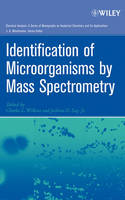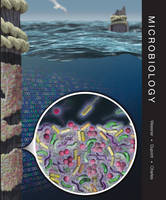Identification of Microorganisms by Mass Spectrometry
 -15%
portes grátis
-15%
portes grátis
Identification of Microorganisms by Mass Spectrometry
Lay, Jackson O.; Wilkins, Charles L.
John Wiley & Sons Inc
01/2006
376
Dura
Inglês
9780471654421
15 a 20 dias
712
Descrição não disponível.
Preface. Contributors.
1. Cultural, Serological and Genetic Methods for Identification of Bacteria (John B. Sutherland and Fatemeh Rafii).
1.1 Introduction.
1.2 Identification of bacteria by cultural methods.
1.3 Identification of bacteria by serological methods.
1.4 Identification of bacteria by genetic methods.
1.5 Other methods used for bacterial characterization.
1.6 Conclusions.
1.7 Acknowledgments and Disclaimers.
1.8 References.
2. Mass Spectrometry: Identification and Biodetection, Lessons Learned and Future Developments (Alvin Fox).
2.1 Introduction.
2.1.1 Analysis of Fatty Acid and Sugar Monomers using GC-FID, GC-MS and GC-MS-MS.
2.1.2 2.2 Analysis of PCR products using PCR, PCR-MS and PCR-MS-MS.
2.1.3 Analysis of proteins using MALDI-TOF MS.
2.1.4 Chemical markers for protein-based identification or biodetection.
2.1.5 Conclusions.
2.1.6 References.
3. An Introduction to Maldi TOF MS Analysis of Whole Bacteria (Rohana Liyanage and Jackson O. Lay, Jr.).
3.1. Introduction.
3.2. Mass Spectrometry and Time-of-Flight MS.
3.3. Matrix Assisted Laser Desorption Ionization.
3.4. MALDI/TOF Mass Spectrometry.
3.5. MALDI TOF and Bacterial Identification.
3.6. Conclusions.
3.7. References.
4. The Development of the Block II Chemical Biological Mass Spectrometer (Wayne H. Griest and Stephen A. Lammert.
4.1. Introduction.
4.2. Development History and Design Philosophy.
4.3. Requirements and Specifications.
4.4. Performance Testing.
4.5. Conclusions.
4.6. Acknowledgements.
4.7 References.
5. Method Reproducibility and Spectral Library Assembly for Rapid Bacterial Characterization by Metastable Atom Bombardment Pyrolysis Mass Spectrometry (Jon G. Wilkes, Gary Miertschin, Todd Eschler, Les Hosey, Fatemeh Rafii, Larry Rushing, Dan A. Buzatu, and Michel J. Bertrand).
5.1. Introduction.
5.2. Sample Preparation for Rapid, Reproducible Cell Culture.
5.3. Analytical instrumentation for sensitive detection and spectral reproducibility.
5.4. Spectral library assembly.
5.5. Pattern Recognition Methods for Objectively Classifying Bacteria.
5.6. Conclusions.
5.7. Acknowledgement and Disclaimer.
5.8. References.
6. MALDI TOF Mass Spectrometry of Intact Bacteria (Jackson O. Lay, Jr., and Rohana Liyanage).
6.1. Introduction.
6.2. MALDI MS of Cellular Extracts.
6.3. Taxonomy: From Isolates to Whole Cell MALDI.
6.4 Whole Cell MALDI MS.
6.5 Biology Based Changes in Whole Cell MALDI Spectra.
6.6 Analysis of Mixtures.
6.7 Experimental Approaches.
6.8 Identification of Protein Markers.
6.9 Analysis of Target Proteins.
6.10 Analysis of Clinical Isolates.
6.11 Conclusions.
6.12 References.
7. Development of Spectral Pattern Matching Approaches to Matrix-Assisted Laser Desorption/Ionization Time-of-Flight Mass Spectrometry for Bacterial Identification (Kristin H. Jarman and Karen L. Wahl).
7.1. Introduction.
7.2. MALDI-MS Signature Library Construction and Identification.
7.3.Future Directions.
7.4. References.
8. Studies of Malaria by Mass Spectrometry (Plamen A. Demirev).
8.1. Introduction.
8.2. Plasmodium in Red Blood Cells.
8.3. Experimental Protocols for LDMS Detection of Malaria.
8.4. Malaria Detection by Laser Desorption Mass Spectrometry.
8.5. MS-Based Proteomics of the Plasmodium Parasite.
8.6. Conclusions.
8.7. Acknowledgements.
8.8. References.
9. Bacterial Strain Differentiation by Mass Spectrometry (Randy J. Arnold, Jonathan A. Karty and James P. Reilly).
9.1. Introduction.
9.2. Analysis of Cellular Proteins by Mass Spectrometry.
9.3. Application of MALDI-TOF to Bacteria Identification.
9.4. Conclusions.
9.5. Acknowledgments.
9.6. References.
10. Bacterial Protein Biomarker Discovery: A Focused Approach to Developing Molecular Based Identification Systems (Tracie L. Williams, Steven R. Monday, and Steven M. Musser).
10.1. Introduction.
10.2. Protein Extraction Methods.
10.3. Mass Spectrometry.
10.4. Automating the Process.
10.5. Collecting and Sequencing Proteins.
10.6. Conclusions.
11. High Throughput Microbial Characterisations Using Electrospray Ionisation Mass Spectrometry and Its Role in Functional Genomics (Seetharaman Vaidyanathan and Royston Goodacre).
11.1. Introduction.
11.2. Microbial characterisations beyond the genomic level: Functional genomics.
11.3. Electrospray (ionization) mass spectrometry (ESMS).
11.4. ESMS of Microbes.
11.5. Direct infusion ESMS of crude cell extracts for high-throughput characterizations - metabolic fingerprinting and footprinting.
11.6. Conclusions.
11.7. Acknowledgements.
11.8. References.
12. Bioinformatics for Flexibility, Reliability and Mixture Analysis of Intact Microorganisms (Catherine Fenselau and Patrick Pribil).
12.1. Introduction.
12.2. Library Matching.
12.3. Machine Learning.
12.4. Bioinformatics.
12.5. Protein Molecular Masses.
12.6. Protein Maps.
12.7 Microsequences from Peptides and Proteins.
12.8 Remaining Challenges.
12.9 Conclusions.
12.10 References.
13. MALDI-FTMS of Whole Cell Bacteria (Jeffrey J. Jones, Michael J. Stump, and Charles L. Wilkins).
13.1. Introduction.
13.2. Fundamentals of MALDI-FTMS.
13.3. Fundmentals of Complex Biological Analysis.
13.4 Whole Cell Characterization Through MALDI-FTMS.
13.5 Recombinant Over-Expressed Proteins Desorbed Directly from Whole Cells.
13.6. Conclusions.
13.7. References.
14. A Review of Antibody Capture and Bacteriophage Amplification in Connection with the Direct Analysis of Whole Cell Bacteria by MALDI-TOF-MS (Kent J. Voorhees and Jon C. Rees).
14.1. Introduction.
14.2. Bacterial Identification.
14.3. Immunocapture of Bacterial Mixtures.
14.4. Bacteriophage Amplification of Bacteria.
14.5. Conclusions.
14.6. References.
15. Discrimination and Identification of Microorganisms by Ppyrolysis Mass Spectrometry: From Burning Ambitions to Cooling Embers - A Historical Perspective (Eadaoin Timmins and Royston Goodacre).
15.1 Introduction to microbial characterisation.
15.2 Principles of PyMS.
15.3 Early developments and investigations (1952 to 1985).
15.4 The mid 1980s and beyond.
15.5 The move from cluster analyses to neural networks.
15.6 Reproducibility of PyMS.
15.7 Acknowledgements.
15.8 References.
Index.
1. Cultural, Serological and Genetic Methods for Identification of Bacteria (John B. Sutherland and Fatemeh Rafii).
1.1 Introduction.
1.2 Identification of bacteria by cultural methods.
1.3 Identification of bacteria by serological methods.
1.4 Identification of bacteria by genetic methods.
1.5 Other methods used for bacterial characterization.
1.6 Conclusions.
1.7 Acknowledgments and Disclaimers.
1.8 References.
2. Mass Spectrometry: Identification and Biodetection, Lessons Learned and Future Developments (Alvin Fox).
2.1 Introduction.
2.1.1 Analysis of Fatty Acid and Sugar Monomers using GC-FID, GC-MS and GC-MS-MS.
2.1.2 2.2 Analysis of PCR products using PCR, PCR-MS and PCR-MS-MS.
2.1.3 Analysis of proteins using MALDI-TOF MS.
2.1.4 Chemical markers for protein-based identification or biodetection.
2.1.5 Conclusions.
2.1.6 References.
3. An Introduction to Maldi TOF MS Analysis of Whole Bacteria (Rohana Liyanage and Jackson O. Lay, Jr.).
3.1. Introduction.
3.2. Mass Spectrometry and Time-of-Flight MS.
3.3. Matrix Assisted Laser Desorption Ionization.
3.4. MALDI/TOF Mass Spectrometry.
3.5. MALDI TOF and Bacterial Identification.
3.6. Conclusions.
3.7. References.
4. The Development of the Block II Chemical Biological Mass Spectrometer (Wayne H. Griest and Stephen A. Lammert.
4.1. Introduction.
4.2. Development History and Design Philosophy.
4.3. Requirements and Specifications.
4.4. Performance Testing.
4.5. Conclusions.
4.6. Acknowledgements.
4.7 References.
5. Method Reproducibility and Spectral Library Assembly for Rapid Bacterial Characterization by Metastable Atom Bombardment Pyrolysis Mass Spectrometry (Jon G. Wilkes, Gary Miertschin, Todd Eschler, Les Hosey, Fatemeh Rafii, Larry Rushing, Dan A. Buzatu, and Michel J. Bertrand).
5.1. Introduction.
5.2. Sample Preparation for Rapid, Reproducible Cell Culture.
5.3. Analytical instrumentation for sensitive detection and spectral reproducibility.
5.4. Spectral library assembly.
5.5. Pattern Recognition Methods for Objectively Classifying Bacteria.
5.6. Conclusions.
5.7. Acknowledgement and Disclaimer.
5.8. References.
6. MALDI TOF Mass Spectrometry of Intact Bacteria (Jackson O. Lay, Jr., and Rohana Liyanage).
6.1. Introduction.
6.2. MALDI MS of Cellular Extracts.
6.3. Taxonomy: From Isolates to Whole Cell MALDI.
6.4 Whole Cell MALDI MS.
6.5 Biology Based Changes in Whole Cell MALDI Spectra.
6.6 Analysis of Mixtures.
6.7 Experimental Approaches.
6.8 Identification of Protein Markers.
6.9 Analysis of Target Proteins.
6.10 Analysis of Clinical Isolates.
6.11 Conclusions.
6.12 References.
7. Development of Spectral Pattern Matching Approaches to Matrix-Assisted Laser Desorption/Ionization Time-of-Flight Mass Spectrometry for Bacterial Identification (Kristin H. Jarman and Karen L. Wahl).
7.1. Introduction.
7.2. MALDI-MS Signature Library Construction and Identification.
7.3.Future Directions.
7.4. References.
8. Studies of Malaria by Mass Spectrometry (Plamen A. Demirev).
8.1. Introduction.
8.2. Plasmodium in Red Blood Cells.
8.3. Experimental Protocols for LDMS Detection of Malaria.
8.4. Malaria Detection by Laser Desorption Mass Spectrometry.
8.5. MS-Based Proteomics of the Plasmodium Parasite.
8.6. Conclusions.
8.7. Acknowledgements.
8.8. References.
9. Bacterial Strain Differentiation by Mass Spectrometry (Randy J. Arnold, Jonathan A. Karty and James P. Reilly).
9.1. Introduction.
9.2. Analysis of Cellular Proteins by Mass Spectrometry.
9.3. Application of MALDI-TOF to Bacteria Identification.
9.4. Conclusions.
9.5. Acknowledgments.
9.6. References.
10. Bacterial Protein Biomarker Discovery: A Focused Approach to Developing Molecular Based Identification Systems (Tracie L. Williams, Steven R. Monday, and Steven M. Musser).
10.1. Introduction.
10.2. Protein Extraction Methods.
10.3. Mass Spectrometry.
10.4. Automating the Process.
10.5. Collecting and Sequencing Proteins.
10.6. Conclusions.
11. High Throughput Microbial Characterisations Using Electrospray Ionisation Mass Spectrometry and Its Role in Functional Genomics (Seetharaman Vaidyanathan and Royston Goodacre).
11.1. Introduction.
11.2. Microbial characterisations beyond the genomic level: Functional genomics.
11.3. Electrospray (ionization) mass spectrometry (ESMS).
11.4. ESMS of Microbes.
11.5. Direct infusion ESMS of crude cell extracts for high-throughput characterizations - metabolic fingerprinting and footprinting.
11.6. Conclusions.
11.7. Acknowledgements.
11.8. References.
12. Bioinformatics for Flexibility, Reliability and Mixture Analysis of Intact Microorganisms (Catherine Fenselau and Patrick Pribil).
12.1. Introduction.
12.2. Library Matching.
12.3. Machine Learning.
12.4. Bioinformatics.
12.5. Protein Molecular Masses.
12.6. Protein Maps.
12.7 Microsequences from Peptides and Proteins.
12.8 Remaining Challenges.
12.9 Conclusions.
12.10 References.
13. MALDI-FTMS of Whole Cell Bacteria (Jeffrey J. Jones, Michael J. Stump, and Charles L. Wilkins).
13.1. Introduction.
13.2. Fundamentals of MALDI-FTMS.
13.3. Fundmentals of Complex Biological Analysis.
13.4 Whole Cell Characterization Through MALDI-FTMS.
13.5 Recombinant Over-Expressed Proteins Desorbed Directly from Whole Cells.
13.6. Conclusions.
13.7. References.
14. A Review of Antibody Capture and Bacteriophage Amplification in Connection with the Direct Analysis of Whole Cell Bacteria by MALDI-TOF-MS (Kent J. Voorhees and Jon C. Rees).
14.1. Introduction.
14.2. Bacterial Identification.
14.3. Immunocapture of Bacterial Mixtures.
14.4. Bacteriophage Amplification of Bacteria.
14.5. Conclusions.
14.6. References.
15. Discrimination and Identification of Microorganisms by Ppyrolysis Mass Spectrometry: From Burning Ambitions to Cooling Embers - A Historical Perspective (Eadaoin Timmins and Royston Goodacre).
15.1 Introduction to microbial characterisation.
15.2 Principles of PyMS.
15.3 Early developments and investigations (1952 to 1985).
15.4 The mid 1980s and beyond.
15.5 The move from cluster analyses to neural networks.
15.6 Reproducibility of PyMS.
15.7 Acknowledgements.
15.8 References.
Index.
Este título pertence ao(s) assunto(s) indicados(s). Para ver outros títulos clique no assunto desejado.
multidisciplinary; analysis; fundamentals; characterization; targeted; approach; proteins; mass spectrometry; bacterial; chemotaxonomy; microorganisms; techniques; identification; overview; wellestablished; identifying; microbiologists
Preface. Contributors.
1. Cultural, Serological and Genetic Methods for Identification of Bacteria (John B. Sutherland and Fatemeh Rafii).
1.1 Introduction.
1.2 Identification of bacteria by cultural methods.
1.3 Identification of bacteria by serological methods.
1.4 Identification of bacteria by genetic methods.
1.5 Other methods used for bacterial characterization.
1.6 Conclusions.
1.7 Acknowledgments and Disclaimers.
1.8 References.
2. Mass Spectrometry: Identification and Biodetection, Lessons Learned and Future Developments (Alvin Fox).
2.1 Introduction.
2.1.1 Analysis of Fatty Acid and Sugar Monomers using GC-FID, GC-MS and GC-MS-MS.
2.1.2 2.2 Analysis of PCR products using PCR, PCR-MS and PCR-MS-MS.
2.1.3 Analysis of proteins using MALDI-TOF MS.
2.1.4 Chemical markers for protein-based identification or biodetection.
2.1.5 Conclusions.
2.1.6 References.
3. An Introduction to Maldi TOF MS Analysis of Whole Bacteria (Rohana Liyanage and Jackson O. Lay, Jr.).
3.1. Introduction.
3.2. Mass Spectrometry and Time-of-Flight MS.
3.3. Matrix Assisted Laser Desorption Ionization.
3.4. MALDI/TOF Mass Spectrometry.
3.5. MALDI TOF and Bacterial Identification.
3.6. Conclusions.
3.7. References.
4. The Development of the Block II Chemical Biological Mass Spectrometer (Wayne H. Griest and Stephen A. Lammert.
4.1. Introduction.
4.2. Development History and Design Philosophy.
4.3. Requirements and Specifications.
4.4. Performance Testing.
4.5. Conclusions.
4.6. Acknowledgements.
4.7 References.
5. Method Reproducibility and Spectral Library Assembly for Rapid Bacterial Characterization by Metastable Atom Bombardment Pyrolysis Mass Spectrometry (Jon G. Wilkes, Gary Miertschin, Todd Eschler, Les Hosey, Fatemeh Rafii, Larry Rushing, Dan A. Buzatu, and Michel J. Bertrand).
5.1. Introduction.
5.2. Sample Preparation for Rapid, Reproducible Cell Culture.
5.3. Analytical instrumentation for sensitive detection and spectral reproducibility.
5.4. Spectral library assembly.
5.5. Pattern Recognition Methods for Objectively Classifying Bacteria.
5.6. Conclusions.
5.7. Acknowledgement and Disclaimer.
5.8. References.
6. MALDI TOF Mass Spectrometry of Intact Bacteria (Jackson O. Lay, Jr., and Rohana Liyanage).
6.1. Introduction.
6.2. MALDI MS of Cellular Extracts.
6.3. Taxonomy: From Isolates to Whole Cell MALDI.
6.4 Whole Cell MALDI MS.
6.5 Biology Based Changes in Whole Cell MALDI Spectra.
6.6 Analysis of Mixtures.
6.7 Experimental Approaches.
6.8 Identification of Protein Markers.
6.9 Analysis of Target Proteins.
6.10 Analysis of Clinical Isolates.
6.11 Conclusions.
6.12 References.
7. Development of Spectral Pattern Matching Approaches to Matrix-Assisted Laser Desorption/Ionization Time-of-Flight Mass Spectrometry for Bacterial Identification (Kristin H. Jarman and Karen L. Wahl).
7.1. Introduction.
7.2. MALDI-MS Signature Library Construction and Identification.
7.3.Future Directions.
7.4. References.
8. Studies of Malaria by Mass Spectrometry (Plamen A. Demirev).
8.1. Introduction.
8.2. Plasmodium in Red Blood Cells.
8.3. Experimental Protocols for LDMS Detection of Malaria.
8.4. Malaria Detection by Laser Desorption Mass Spectrometry.
8.5. MS-Based Proteomics of the Plasmodium Parasite.
8.6. Conclusions.
8.7. Acknowledgements.
8.8. References.
9. Bacterial Strain Differentiation by Mass Spectrometry (Randy J. Arnold, Jonathan A. Karty and James P. Reilly).
9.1. Introduction.
9.2. Analysis of Cellular Proteins by Mass Spectrometry.
9.3. Application of MALDI-TOF to Bacteria Identification.
9.4. Conclusions.
9.5. Acknowledgments.
9.6. References.
10. Bacterial Protein Biomarker Discovery: A Focused Approach to Developing Molecular Based Identification Systems (Tracie L. Williams, Steven R. Monday, and Steven M. Musser).
10.1. Introduction.
10.2. Protein Extraction Methods.
10.3. Mass Spectrometry.
10.4. Automating the Process.
10.5. Collecting and Sequencing Proteins.
10.6. Conclusions.
11. High Throughput Microbial Characterisations Using Electrospray Ionisation Mass Spectrometry and Its Role in Functional Genomics (Seetharaman Vaidyanathan and Royston Goodacre).
11.1. Introduction.
11.2. Microbial characterisations beyond the genomic level: Functional genomics.
11.3. Electrospray (ionization) mass spectrometry (ESMS).
11.4. ESMS of Microbes.
11.5. Direct infusion ESMS of crude cell extracts for high-throughput characterizations - metabolic fingerprinting and footprinting.
11.6. Conclusions.
11.7. Acknowledgements.
11.8. References.
12. Bioinformatics for Flexibility, Reliability and Mixture Analysis of Intact Microorganisms (Catherine Fenselau and Patrick Pribil).
12.1. Introduction.
12.2. Library Matching.
12.3. Machine Learning.
12.4. Bioinformatics.
12.5. Protein Molecular Masses.
12.6. Protein Maps.
12.7 Microsequences from Peptides and Proteins.
12.8 Remaining Challenges.
12.9 Conclusions.
12.10 References.
13. MALDI-FTMS of Whole Cell Bacteria (Jeffrey J. Jones, Michael J. Stump, and Charles L. Wilkins).
13.1. Introduction.
13.2. Fundamentals of MALDI-FTMS.
13.3. Fundmentals of Complex Biological Analysis.
13.4 Whole Cell Characterization Through MALDI-FTMS.
13.5 Recombinant Over-Expressed Proteins Desorbed Directly from Whole Cells.
13.6. Conclusions.
13.7. References.
14. A Review of Antibody Capture and Bacteriophage Amplification in Connection with the Direct Analysis of Whole Cell Bacteria by MALDI-TOF-MS (Kent J. Voorhees and Jon C. Rees).
14.1. Introduction.
14.2. Bacterial Identification.
14.3. Immunocapture of Bacterial Mixtures.
14.4. Bacteriophage Amplification of Bacteria.
14.5. Conclusions.
14.6. References.
15. Discrimination and Identification of Microorganisms by Ppyrolysis Mass Spectrometry: From Burning Ambitions to Cooling Embers - A Historical Perspective (Eadaoin Timmins and Royston Goodacre).
15.1 Introduction to microbial characterisation.
15.2 Principles of PyMS.
15.3 Early developments and investigations (1952 to 1985).
15.4 The mid 1980s and beyond.
15.5 The move from cluster analyses to neural networks.
15.6 Reproducibility of PyMS.
15.7 Acknowledgements.
15.8 References.
Index.
1. Cultural, Serological and Genetic Methods for Identification of Bacteria (John B. Sutherland and Fatemeh Rafii).
1.1 Introduction.
1.2 Identification of bacteria by cultural methods.
1.3 Identification of bacteria by serological methods.
1.4 Identification of bacteria by genetic methods.
1.5 Other methods used for bacterial characterization.
1.6 Conclusions.
1.7 Acknowledgments and Disclaimers.
1.8 References.
2. Mass Spectrometry: Identification and Biodetection, Lessons Learned and Future Developments (Alvin Fox).
2.1 Introduction.
2.1.1 Analysis of Fatty Acid and Sugar Monomers using GC-FID, GC-MS and GC-MS-MS.
2.1.2 2.2 Analysis of PCR products using PCR, PCR-MS and PCR-MS-MS.
2.1.3 Analysis of proteins using MALDI-TOF MS.
2.1.4 Chemical markers for protein-based identification or biodetection.
2.1.5 Conclusions.
2.1.6 References.
3. An Introduction to Maldi TOF MS Analysis of Whole Bacteria (Rohana Liyanage and Jackson O. Lay, Jr.).
3.1. Introduction.
3.2. Mass Spectrometry and Time-of-Flight MS.
3.3. Matrix Assisted Laser Desorption Ionization.
3.4. MALDI/TOF Mass Spectrometry.
3.5. MALDI TOF and Bacterial Identification.
3.6. Conclusions.
3.7. References.
4. The Development of the Block II Chemical Biological Mass Spectrometer (Wayne H. Griest and Stephen A. Lammert.
4.1. Introduction.
4.2. Development History and Design Philosophy.
4.3. Requirements and Specifications.
4.4. Performance Testing.
4.5. Conclusions.
4.6. Acknowledgements.
4.7 References.
5. Method Reproducibility and Spectral Library Assembly for Rapid Bacterial Characterization by Metastable Atom Bombardment Pyrolysis Mass Spectrometry (Jon G. Wilkes, Gary Miertschin, Todd Eschler, Les Hosey, Fatemeh Rafii, Larry Rushing, Dan A. Buzatu, and Michel J. Bertrand).
5.1. Introduction.
5.2. Sample Preparation for Rapid, Reproducible Cell Culture.
5.3. Analytical instrumentation for sensitive detection and spectral reproducibility.
5.4. Spectral library assembly.
5.5. Pattern Recognition Methods for Objectively Classifying Bacteria.
5.6. Conclusions.
5.7. Acknowledgement and Disclaimer.
5.8. References.
6. MALDI TOF Mass Spectrometry of Intact Bacteria (Jackson O. Lay, Jr., and Rohana Liyanage).
6.1. Introduction.
6.2. MALDI MS of Cellular Extracts.
6.3. Taxonomy: From Isolates to Whole Cell MALDI.
6.4 Whole Cell MALDI MS.
6.5 Biology Based Changes in Whole Cell MALDI Spectra.
6.6 Analysis of Mixtures.
6.7 Experimental Approaches.
6.8 Identification of Protein Markers.
6.9 Analysis of Target Proteins.
6.10 Analysis of Clinical Isolates.
6.11 Conclusions.
6.12 References.
7. Development of Spectral Pattern Matching Approaches to Matrix-Assisted Laser Desorption/Ionization Time-of-Flight Mass Spectrometry for Bacterial Identification (Kristin H. Jarman and Karen L. Wahl).
7.1. Introduction.
7.2. MALDI-MS Signature Library Construction and Identification.
7.3.Future Directions.
7.4. References.
8. Studies of Malaria by Mass Spectrometry (Plamen A. Demirev).
8.1. Introduction.
8.2. Plasmodium in Red Blood Cells.
8.3. Experimental Protocols for LDMS Detection of Malaria.
8.4. Malaria Detection by Laser Desorption Mass Spectrometry.
8.5. MS-Based Proteomics of the Plasmodium Parasite.
8.6. Conclusions.
8.7. Acknowledgements.
8.8. References.
9. Bacterial Strain Differentiation by Mass Spectrometry (Randy J. Arnold, Jonathan A. Karty and James P. Reilly).
9.1. Introduction.
9.2. Analysis of Cellular Proteins by Mass Spectrometry.
9.3. Application of MALDI-TOF to Bacteria Identification.
9.4. Conclusions.
9.5. Acknowledgments.
9.6. References.
10. Bacterial Protein Biomarker Discovery: A Focused Approach to Developing Molecular Based Identification Systems (Tracie L. Williams, Steven R. Monday, and Steven M. Musser).
10.1. Introduction.
10.2. Protein Extraction Methods.
10.3. Mass Spectrometry.
10.4. Automating the Process.
10.5. Collecting and Sequencing Proteins.
10.6. Conclusions.
11. High Throughput Microbial Characterisations Using Electrospray Ionisation Mass Spectrometry and Its Role in Functional Genomics (Seetharaman Vaidyanathan and Royston Goodacre).
11.1. Introduction.
11.2. Microbial characterisations beyond the genomic level: Functional genomics.
11.3. Electrospray (ionization) mass spectrometry (ESMS).
11.4. ESMS of Microbes.
11.5. Direct infusion ESMS of crude cell extracts for high-throughput characterizations - metabolic fingerprinting and footprinting.
11.6. Conclusions.
11.7. Acknowledgements.
11.8. References.
12. Bioinformatics for Flexibility, Reliability and Mixture Analysis of Intact Microorganisms (Catherine Fenselau and Patrick Pribil).
12.1. Introduction.
12.2. Library Matching.
12.3. Machine Learning.
12.4. Bioinformatics.
12.5. Protein Molecular Masses.
12.6. Protein Maps.
12.7 Microsequences from Peptides and Proteins.
12.8 Remaining Challenges.
12.9 Conclusions.
12.10 References.
13. MALDI-FTMS of Whole Cell Bacteria (Jeffrey J. Jones, Michael J. Stump, and Charles L. Wilkins).
13.1. Introduction.
13.2. Fundamentals of MALDI-FTMS.
13.3. Fundmentals of Complex Biological Analysis.
13.4 Whole Cell Characterization Through MALDI-FTMS.
13.5 Recombinant Over-Expressed Proteins Desorbed Directly from Whole Cells.
13.6. Conclusions.
13.7. References.
14. A Review of Antibody Capture and Bacteriophage Amplification in Connection with the Direct Analysis of Whole Cell Bacteria by MALDI-TOF-MS (Kent J. Voorhees and Jon C. Rees).
14.1. Introduction.
14.2. Bacterial Identification.
14.3. Immunocapture of Bacterial Mixtures.
14.4. Bacteriophage Amplification of Bacteria.
14.5. Conclusions.
14.6. References.
15. Discrimination and Identification of Microorganisms by Ppyrolysis Mass Spectrometry: From Burning Ambitions to Cooling Embers - A Historical Perspective (Eadaoin Timmins and Royston Goodacre).
15.1 Introduction to microbial characterisation.
15.2 Principles of PyMS.
15.3 Early developments and investigations (1952 to 1985).
15.4 The mid 1980s and beyond.
15.5 The move from cluster analyses to neural networks.
15.6 Reproducibility of PyMS.
15.7 Acknowledgements.
15.8 References.
Index.
Este título pertence ao(s) assunto(s) indicados(s). Para ver outros títulos clique no assunto desejado.




